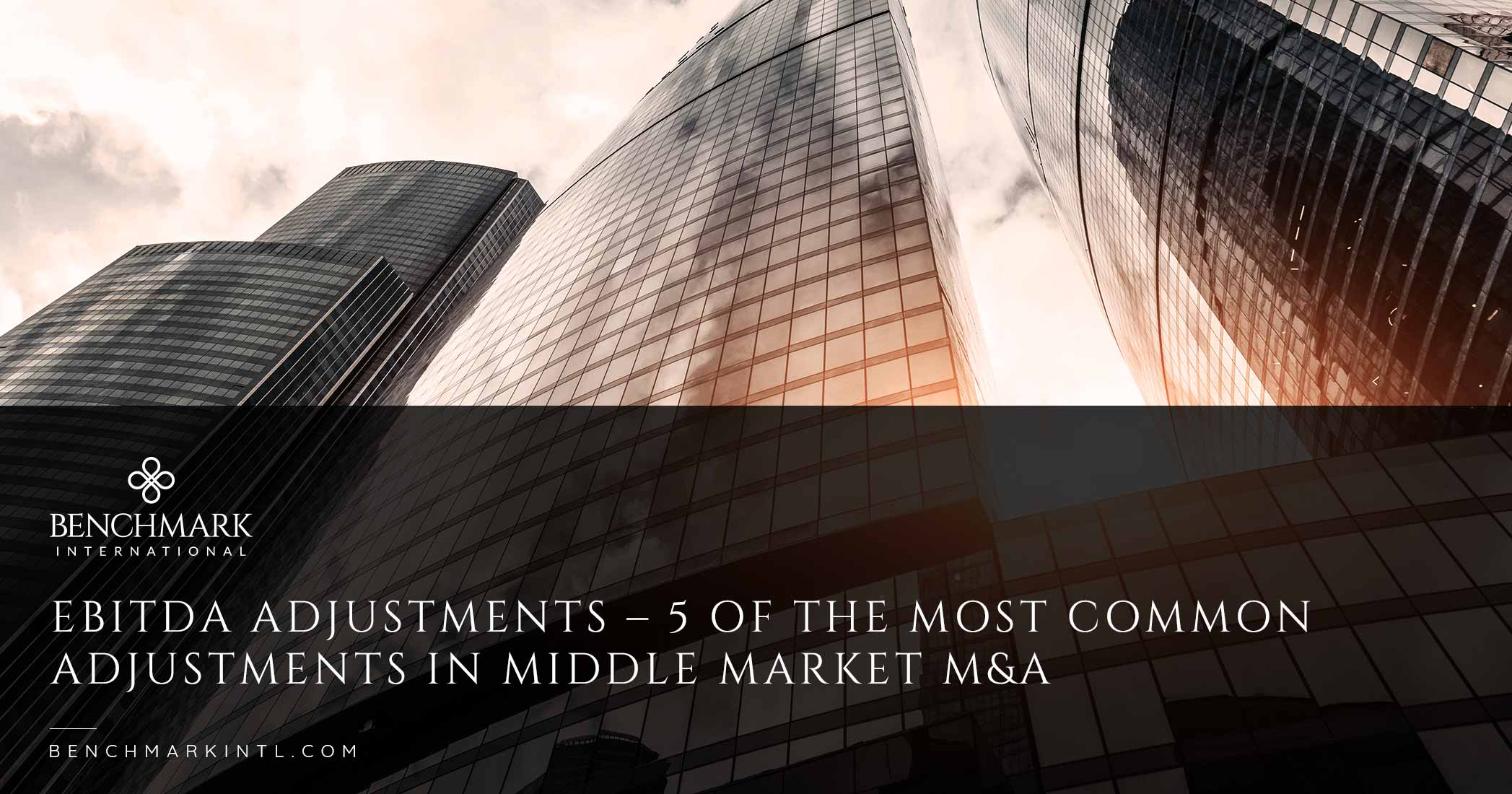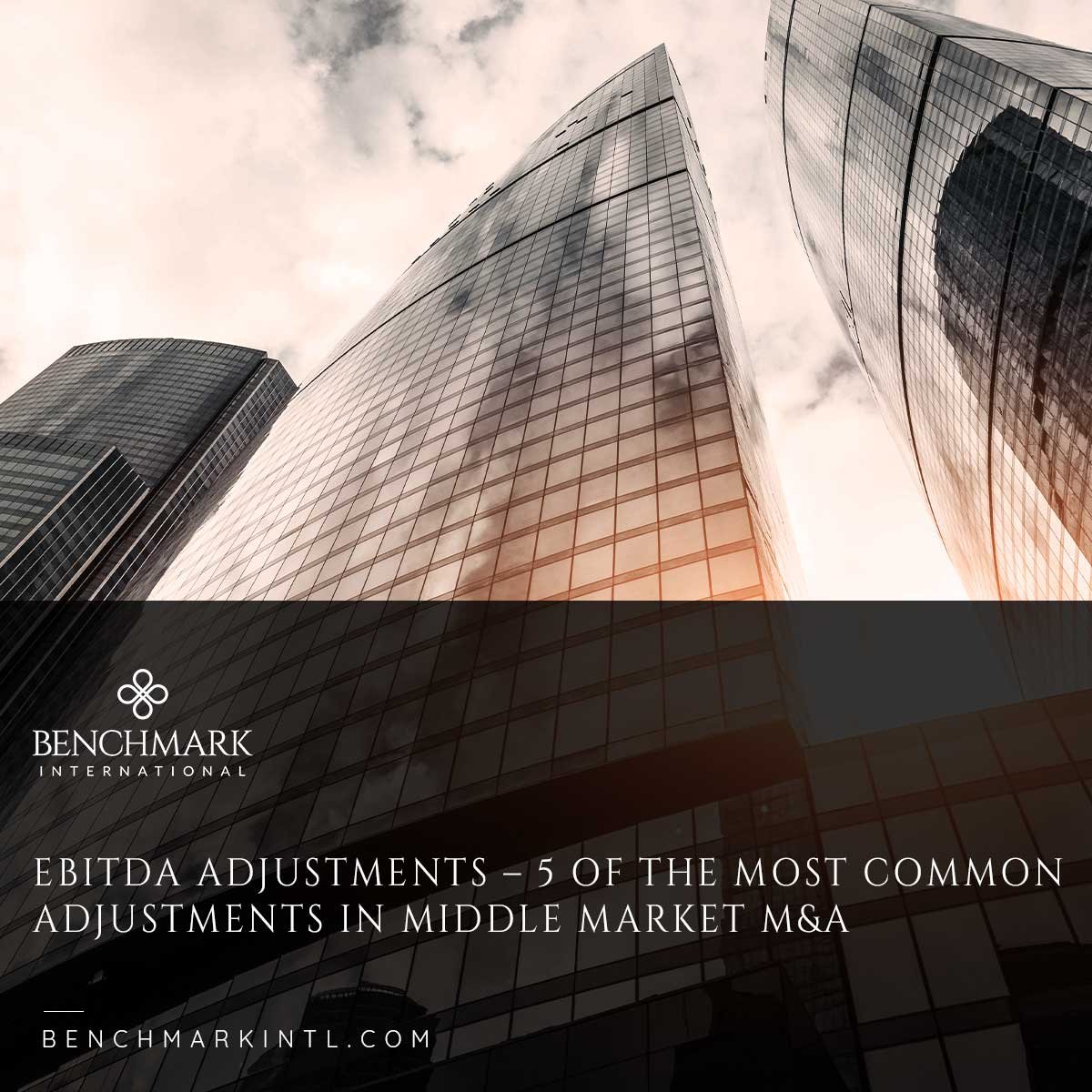
Correctly calculating adjusted EBITDA is essential in an M&A transaction, and all parties must be familiar with the adjustments. EBITDA is used to evaluate a company’s profitability of its core operations by removing items dependent on capital structure, such as interest,
taxes, depreciation, and amortization. Adjusted EBITDA is calculated by taking the company’s book EBITDA and adding or subtracting out one-time and irregular events that are not a part of normal business operations. Adjusted EBITDA provides a normalized view of the business’ net operating income by eliminating anomalies and is a valuable tool used to compare companies in similar industries.
Detailed below are five of the most common EBITDA adjustments in a middle market M&A transaction:
Owner’s Compensation
Owners of middle-market businesses frequently compensate themselves based on several discretionary factors. The owner has many options to pay themself with. Examples of these options and channels include a salary above the market rate in operating expenses or distributions on the balance sheet. If the owner compensates with an above-market salary expensed in operating expenses, the best practice is to add back the difference between the owner’s actual salary and the market value of a salary paid to someone to perform the same duties as the owner. If the owner is compensated through distributions on the balance sheet, no adjustment can be made because these payments are on the balance sheet and do not affect EBITDA or net income. Also added are the salaries of the owner’s spouse, children, relatives, or friends who are inactive in business operations.

Rent
If the company or an affiliated entity owns the real estate on which the business operates, management may choose to pay above-market rent or not pay any rent. It is essential to adjust the rent to reflect market rates to normalize the expenditure on this line item since the amount paid or not paid to rent can vastly fluctuate based on the owner’s discretion.
Owner’s Personal Expenses
Sometimes owners run personal expenses through the business. Frequently this includes gas or maintenance for personal vehicles, personal travel, and personal meals & entertainment. Since these personal expenses are not a part of everyday business operations and typically are found on the income statement, they should be added back to EBITDA.
Professional Fees
Professional fees are often one-time fees or events that are abnormal and non-recurring. These fees are not a part of everyday business activities and are typically added back to EBITDA. Legal fees are frequently added back in this adjustment due to the non-recurring nature of this expense. Also included in this adjustment are fees for filing for a government-funded ERTC or a PPP Loan since these events are not a part of normal business operations. It is important in this adjustment category to distinguish one-time events from events that occur in normal business operations. For example, outsourcing accounting work is a professional fee, but it is not added back to EBITDA because this fee is a necessity to run the business; however, the accounting fee for filing for an ETRC or PPP Loan is added back to EBITDA because it is not apart of normal business operations.

Income Sources Not Related to Regular Business Operations
When managing a middle market business, an owner often seeks to generate revenue outside of regular business operations. The owner may sell an old asset, invest the company’s funds into trading investments, or apply for government funding from grants or PPP Loans. Since these sources generate income that is not a part of normal business activities, they must be subtracted from EBITDA to provide a normalized picture of the company’s financials.
In conclusion, calculating adjusted EBITDA provides potential buyers with a financial metric that they can use to compare multiple businesses’ cash flows in similar industries. The five most common adjustments in middle market M&A transactions are owner’s compensation, rent, owner’s expenses, professional fees, and income sources unrelated to regular business operations. When all parties in the M&A transaction are familiar with adjusted EBITDA and the added and subtracted adjustments, the financial analysis will run smoothly, and an agreement on the value of the business between the buyers and sellers will be easier to establish.
Author
Zachary Eiting
Transaction Support Analyst
Benchmark International
T: +1 615 924 8506
E: zeiting@benchmarkintl.com
Americas: Sam Smoot at +1 (813) 898 2350 / Smoot@BenchmarkIntl.com
Europe: Michael Lawrie at +44 (0) 161 359 4400 / Lawrie@BenchmarkIntl.com
Africa: Anthony McCardle at +27 21 300 2055 / McCardle@BenchmarkIntl.com
ABOUT BENCHMARK INTERNATIONAL:
Benchmark International is a global M&A firm that provides business owners with creative, value-maximizing solutions for growing and exiting their businesses. Benchmark International has handled over $10 billion in transaction value across various industries from offices across the world. With decades of M&A experience, Benchmark International’s transaction teams have assisted business owners with achieving their objectives and ensuring the continued growth of their businesses. The firm has also been named the Investment Banking Firm of the Year by The M&A Advisor and the Global M&A Network as well as the #1 Sell-side Exclusive M&A Advisor in the World by Pitchbook’s Global League Tables.
Website: http://www.benchmarkintl.com
Blog: http://blog.benchmarkcorporate.com

 Benchmark International
Benchmark International  Benchmark International
Benchmark International 





